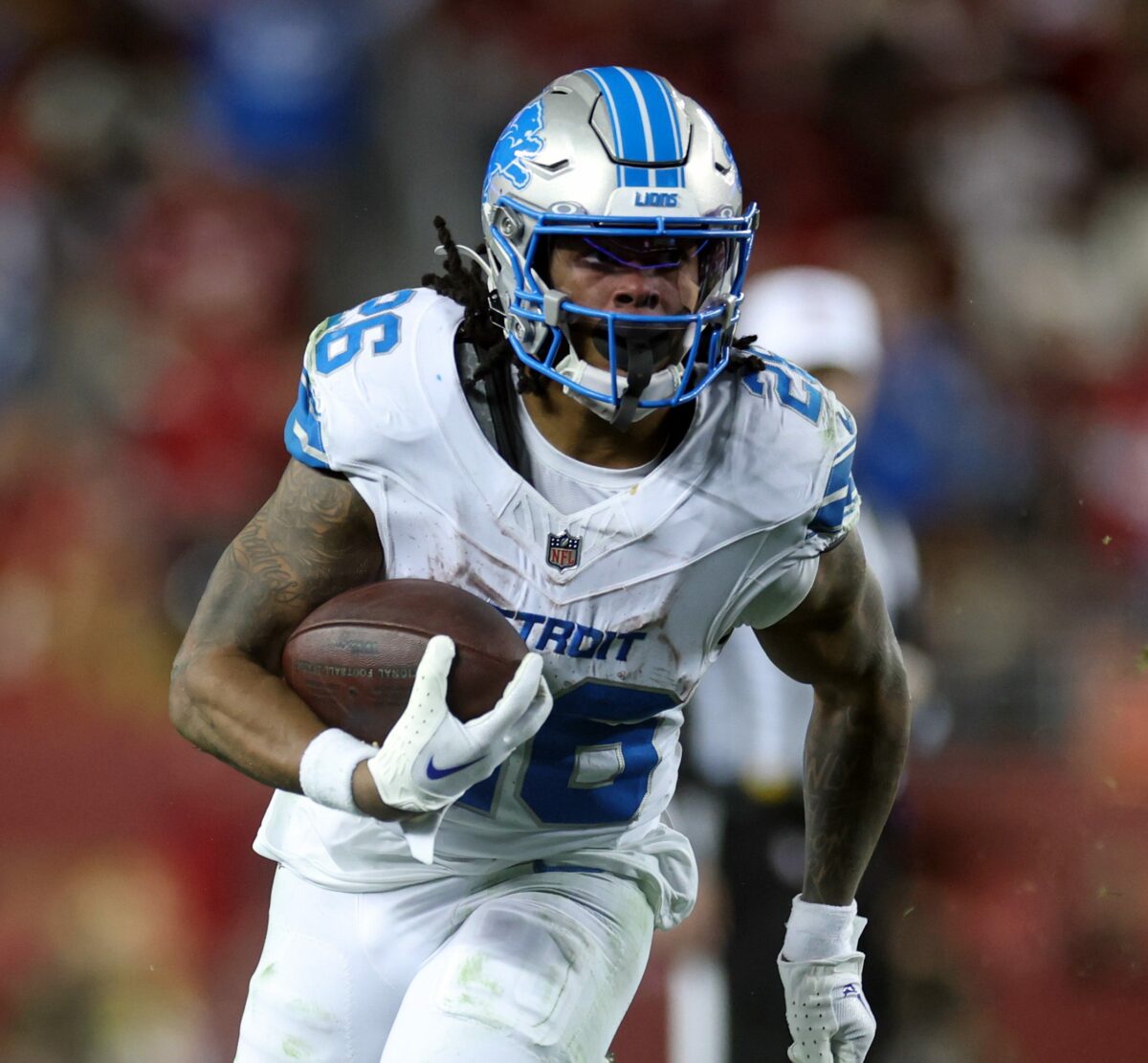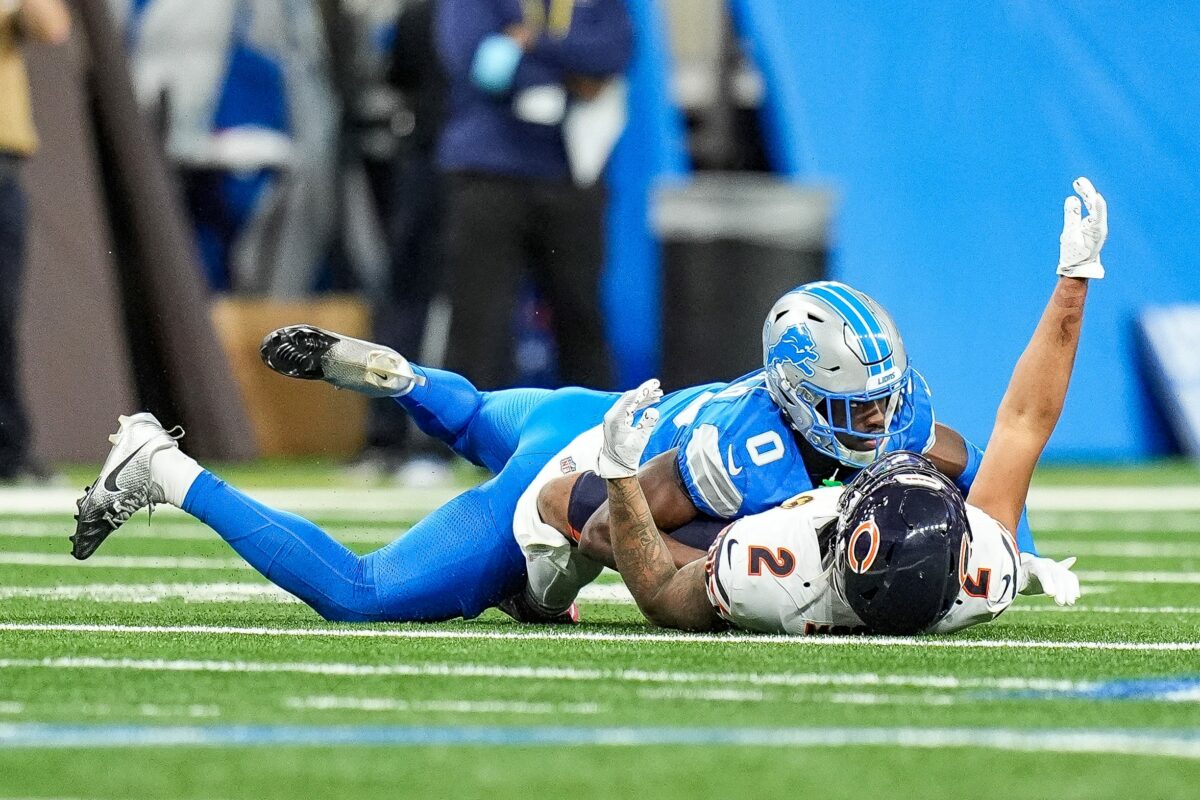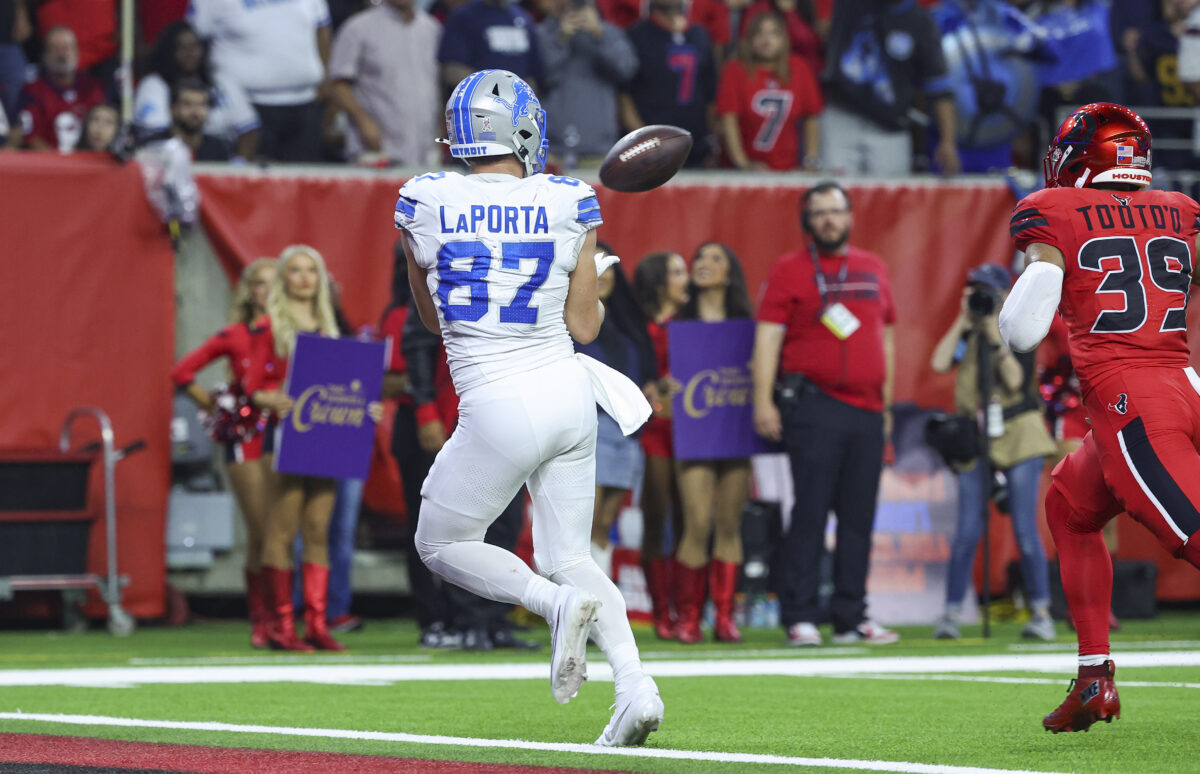When the Detroit Lions selected running back Jahmry Gibbs in the 2023 NFL Draft, there was a lot of uncertainty around what he was going to be for them. Much of that was due to the Lions already having D’Andre Swift and David Montgomery. At the time, Montgomery had just signed a contract with Detroit and it felt like the running back room would be crowded.
On the second day of the 2023 NFL Draft, the vision of the running back room in Detroit became clearer. The Lions traded D’Andre Swift to the Philadelphia Eagles and from there, the rest is history.
Over the last two seasons, we’ve seen Gibbs and Montgomery split time in the Lions backfield. It’s led to some tremendous results as the backs compliment each other so well. Since becoming teammates and earning the nicknames “Sonic” and “Knuckles”, they’ve combined for over 4,400 scrimmage yards and 56 touchdowns. This has helped the Lions compile a 27-7 record during that span (best in the NFL).
Earlier this year when David Montgomery went down with an MCL injury, there were concerns about the Lions offense. Could Jahmyr Gibbs show that he could be the lead back for the Lions? He showed it during the 2023 season when Montgomery went down with an injury, however, it was a small sample size (two games).
In those two games, he had 51 touches for 315 yards and two touchdowns. Some terrific numbers but could he handle a full workload for the reminder of the season? There was speculation that Montgomery wouldn’t play again this year. That’s changed as he’s expected back for the Lions playoff game next week.
That said, Gibbs has been spectacular as the Lions lead back. Since Montgomery got hurt in the Bills game, Gibbs has recorded the following stats:
- Week 16 vs. Chicago | 27 touches for 154 yards and two touchdowns
- Week 17 vs. San Francisco | 22 touches for 163 yards and one touchdown
- Week 18 vs. Minnesota | 28 touches for 170 yards and four touchdowns
Over these last three weeks, Gibbs is 3rd in the NFL in rushing yards with 365 rushing yards. His six total touchdowns are tied for 1st at the running back position during that span. Let’s dive into some film to see what Jahmyr Gibbs has been providing for the Lions offense!
Jahmyr Gibbs has become the total package for the Lions offense. Great vision and burst on this run. Folks, he’s just different. #OnePride pic.twitter.com/KxeTTjx1gz
— Russell Brown (@RussNFLDraft) January 9, 2025
Starting with the play that I used to highlight Gibbs as the total package. It’s a run that showcases his vision and burst. Looking at the play above, the Lions come out under center with their ’12’ personnel (one running back and two tight ends).
Aligned tight to the line of scrimmage, you’ll see Amon-Ra St. Brown and prior to the snap, you’ll see Brock Wright go in motion to the left. Once the ball is snapped, you’ll see double teams between the guards and tackles on both sides of the center. This is a Duo concept and as the play develops, you can see both guards climb to the second level to the linebackers.
Tremendous blocks across the board for the Lions offensive line, especially right tackle Penei Sewell and center Frank Ragnow. They win both of their blocks with ease and it helps keep Gibbs free so he can read the linebackers. Once he sees the opening, he takes over from there and puts his foot on the gas.
Using terrific burst to get through the second level, Gibbs is off to the races. He begins to run out of room as the defender takes a good angle downfield to force him to slow down along the sideline and get tackled. Ultimately, this was a gain of 47 yards.
The first Gibbs TD is so damn pretty. #OnePride pic.twitter.com/YLGrL1Mns5
— Russell Brown (@RussNFLDraft) January 8, 2025
Moving to the next play, it was the first touchdown scored from Jahmyr Gibbs against the Vikings on Sunday night. Looking at that play above, the Lions come out under center with their ’12’ personnel (one running back and two tight ends). They’re aligned in an offset I-formation and tight end Brock Wright lead blocks through the hole to the middle linebacker.
Once the ball is snapped, it looks like Gibbs gets shot out of a cannon. With a massive opening, he’s able to get through that opening with ease and all that’s meeting him at the second level is a safety that is buzzing down.
Gibbs hits another gear as he shakes that safety. With help from Amon-Ra St. Brown picking up a key block on the perimeter, Gibbs is able to use his speed to run free to the end zone.
Similar to what I just posted about Goff taking routes underneath, he does so here on this pass as well. Big reason to why he got the ball out was due to the blitz pickup from Gibbs. #OnePride pic.twitter.com/3e9yX0x76p
— Russell Brown (@RussNFLDraft) January 8, 2025
It’s not all about loading the stat sheet for Gibbs either. Looking at the play above, the Lions will come out in a condensed 2×2 set with their ’11’ personnel (one running back and one tight end). Prior to the snap, Jared Goff will put Jameson Williams in motion to the left of the formation and it puts the Lions in a trips left formation.
Once the ball is snapped, Goff will take the ball and fake the handoff to Gibbs. In the process, Gibbs immediately notices a blitz off the edge. Staying square with low pad level, Gibbs is able to stay under control and pick the blitz up. Despite putting his head down, he does just enough to slow the defender down. This gives Goff enough time to throw this ball to Amon-Ra St. Brown.
Jahmyr Gibbs makes everything look so easy. #OnePride pic.twitter.com/gheof5OhAM
— Russell Brown (@RussNFLDraft) January 9, 2025
Lastly, I want to focus on Gibbs catching passes out of the backfield. He was able to record 52 receptions in each season of his career so far. Much of his production as a pass catcher is due to his ability to use his quickness to create separation from defenders.
Looking at the play above, you’ll see just that from him. Faced was 4th and 1, the Lions came out in a trips left formation with their ’11’ personnel (one running back and one tight end). Prior to the snap, Goff will put Sam LaPorta in motion to the right of the formation.
Once the ball is snapped, Goff is faced with a six-man pressure from the Vikings defense. Coming out of the backfield is Gibbs and due to the blitz, he’s one-on-one with an outside linebacker that gets too far upfield. Using his speed to break free from the defender, Gibbs is able to get vertical quickly and runs a Texas route. With good protection, Goff is able to fire this pass to him and it leads to another touchdown for Detroit.
Since Montgomery went down with injury, Gibbs has recorded 13 receptions during that span (best in the NFL). Not having Montgomery has forced the Lions to get creative on key downs with shorter distances but it’s clear that Jahmyr Gibbs is one of the best running backs in the league.
Overall, he’s used this past month to show that he can be the number-one running back in this league. Most importantly, he showed that the Lions have no regrets for selecting him with the 12th overall pick in the 2023 NFL Draft. It’s clear through two seasons in the NFL that Jahmry Gibbs has turned into the total package for the Detroit Lions offense.


 (@ASchatzNFL)
(@ASchatzNFL) 













